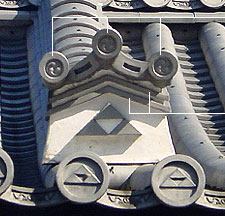|
||
 |
||
|
|||||||||||||
3@Also *Shishi tq. A noh mask *noumen \Κ representing a type of Chinese lion. Like a roaring lion, shishiguchi has a squarely open mouth displaying metallic gold teeth, fangs and a large red tongue. Between the metallic gold eyes that peer majestically out from beneath strong, thick eyebrows rests a wide, flat nose. Gold-colored shishiguchi are sometimes called dei-shishiguchi to distinguish them from the less common, red-colored shishiguchi. Kanze Ο’ style shishi masks tend to have bare heads and large fangs, but Houshou σΆ style shishi have a black line across the top of their foreheads, which in human masks would indicate the base of a black lacquer hat kanmuri ₯ and are thus known as kanmurigata shishi ₯`q. A fine 16c. example belongs to the Tokugawa Ώμ Art Museum, Aichi prefecture. While many shishi masks of Chinese origin can be found in the dengaku and gigaku repertoires, the various noh shishiguchi masks are Japanese in origin. Used for the second act of the play *SHAKKYOU Ξ΄ (Stone Bridge) for the role of the father lion who dances boisterously among the peony flowers in *Monju Άκ Bodhisattva's paradise. Sometimes, one or more child shishi wearing a *shigami θό mask or a smaller version of shishi known as kojishi ¬q (child lion), accompanies the father. A Muromachi period example of the child shishi with menacing up-turned eyes belongs to the Houshoukai σΆο, Tokyo and is designated an Important Cultural Property. Attributed to Shakuzuru Yoshinari Τίg¬@(13c.?, see *jissaku \μ). See *kijinmen S_Κ
@
(C)2001 Japanese Architecture and Art Net Users System.@No reproduction or republication without written permission.
fΪΜeLXgEΚ^ECXgΘΗASΔΜRecΜ³f‘»E]ΪπΦΆά·B


